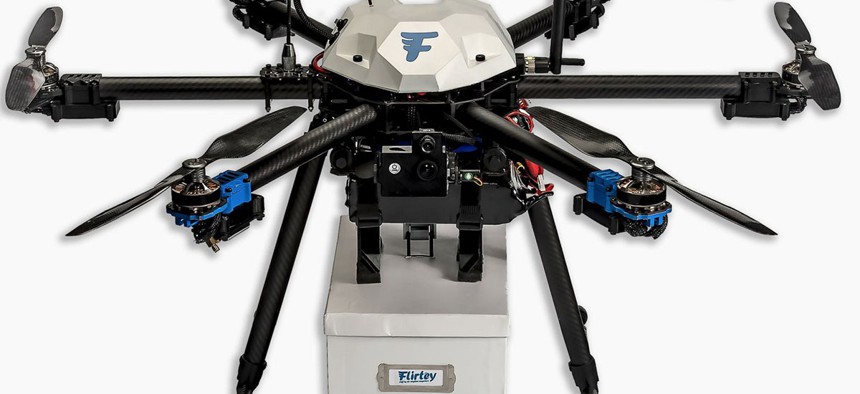The First Drone to Complete a Delivery in the US Is On its Way to the Smithsonian

Flirtey
It was a “Kitty Hawk moment” for the drone industry.
It was a “Kitty Hawk moment” for the drone industry, in the words of Matt Sweeney, the CEO of the Australian drone delivery company Flirtey.
It was all over in less than ten minutes, but the first drone sanctioned by the US Federal Aviation Administration to complete a delivery successfully dropped off medical supplies at a clinic in rural Virginia on July 17, 2015.
Now, Sweeney is donating that historic drone to the Smithsonian’s National Air and Space Museum, in Washington, DC, which houses the Wright Flyer, which the Wright brothers tested in Kitty Hawk, North Carolina, in 1903, ushering in the “aerial age.”
The Air and Space Museum confirmed that the six-propellor drone has been received by the museum, but due to the sheer number of items in its collection, a representative for the museum couldn’t say when it would be put on display.
Although the drone industry is still in its infancy—the FAA has still not even set ground rules for companies wishing to operate delivery services—Sweeney believes that last year’s first drone delivery will herald a new era. “This will be the first of millions of drone deliveries in the US,” he said.
Flirtey is now based in Nevada, where it conducts its research and development. It has partnered with New Zealand companies, including the courier service Fastway and the auction site Trade Me, and has been testing there for over a year.
In the race to be first, Sweeney’s small company beat out US tech giants such as Alphabet, Amazon, and Walmart, all of which are in various stages of testing out drone delivery systems, to be the FAA’s trial partner last year. That first delivery was a milestone for several reasons. It’s not just technical hurdles that companies need to overcome, but also the vast logistical and regulatory spider web that is the FAA’s current stance on commercial drones.
Right now, any company that wants to use a drone for a business has to file for an exemption with the FAA. There is a backlog that the government is working through, and the current regulations don’t really address how a network of delivery drones could be folded into the national airspace. Recently, the Senate approved a bill that would require the FAA to have a regulatory framework in place for drone deliveries in the next two years, but that bill still needs to pass the House of Representatives, and its fate is unclear.
Then there’s the issue of actually setting up this network: The FAA is working with NASA—along with Flirtey and other companies—to set up an air-traffic control system for commercial drones, similar to what is used for airplanes. But the FAA has missed important Congress-mandated deadlines before, so there’s no guarantee that we’ll be seeing millions of drones—Flirtey’s or otherwise—delivering goods to US households anytime soon.
But Sweeney remains optimistic. “Now people feel this as an inevitability,” Sweeney said. “This is now just a question of when, not if.”
NEXT STORY: SpaceX Plans to Head for Mars as Soon as 2018


